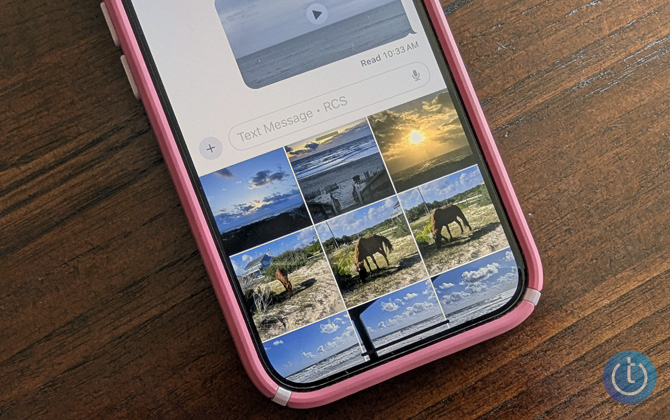The long-standing divide between iPhone and Android users in text messaging has finally been bridged. With yesterday's release of iOS 18, iPhones can now send RCS (Rich Communication Services) messages, bringing a host of advanced features to cross-platform texting that were missing from traditional text messaging – SMS and MMS.

As someone who's experienced this divide firsthand – my kids and I use iPhones while my husband uses an Android – I've seen how it impacts our everyday communication. Sharing high-quality photos and videos wasn't possible and maintaining group chats was challenging. And texting between platforms over WiFi (for example, when one of us was on an airplane) simply wasn't possible. With RCS, we can now enjoy enhanced messaging features as a family, similar to what each of us had previously only been accustomed to within our own ecosystems.
The huge benefits of using RCS
Gone are the days of sending pixelated, unwatchable compressed videos. Previously, iMessage users were able to send high-resolution photos and videos to each other because the messages were sent using cellular or WiFi data, allowing videos up to 100MB in size. But Android users were sent media via the ancient MMS system, which has a paltry 3MB or lower limit. With Apple's adoption of RCS, media sent from iPhone users can now take advantage of the RCS 100MB size limit.
One of the most practical improvements with RCS is the ability to send messages over WiFi. This is especially useful on airplanes or inside buildings were cellular coverage is limited. Now Android users in these situations can still communicate with iPhone users and vice versa.
Read more: How to Use WiFi Calling on Your iPhone
RCS also brings more insight to what's happening during cross-platform conversations. You'll now be able to see when your Android friends are typing a response and know when they've received and read your messages, just as you can with iMessages. And you can name group chats and add and remove people from groups, without messages getting lost or misdirected.
What you're still missing with RCS
While RCS brings iPhone and Android messaging closer together, some differences remain. The most obvious is the color-coding on your iPhone: iMessages will continue to appear in blue bubbles, while RCS messages (like traditional SMS) will show up in green.
A more substantive difference is that you still don't have end-to-end encryption (E2EE) of texts between iPhones and Android phones. Your regular text messages don't support E2EE and RCS doesn't support E2EE cross platform like it does between Android devices. In the meantime, you'll need to stick with an app like WhatsApp for your secure cross-platform chats.
Also, some iMessage-specific features won't be available in RCS conversations. For instance, you won't be able to use special texting effects like invisible ink or screen-filling animations of balloons when messaging Android users. And features like iMessage games or the ability to send and receive money through Apple Pay Cash will remain exclusive to iMessage conversations between Apple users.
How to get RCS
For iPhone users eager to take advantage of RCS messaging, it is rolling out with iOS 18 and all major U.S. carriers – AT&T, T-Mobile, and Verizon – support this technology. If you're using a smaller carrier, there's an easy way to verify if your carrier supports RCS:
- Open the Settings app.
- Select General and then About.
- Scroll down to "Carrier." You'll see your carrier's name next to it. Tap on Carrier, and it will switch to IMS Status. You will see "Voice, SMS & RCS if your carrier supports RCS." If it doesn't support RCS, you'll just see "Voice & SMS."
RCS messaging should be on by default with iOS 18, but if you want to double-check or need to turn it on manually, here's how:
- Open the Settings app.
- Select Apps and then Messages.
- Scroll down to the "Text Messaging" section and select RCS Messaging. Toggle on RCS Messaging.
In the Messages app, you can easily see why type of message you're sending. You'll see either "iMessage" or "Text Message - RCS" in the input box, indicating which protocol you're using.
Read more: What's Draining Your iPhone Battery?
It's worth noting that while RCS is now available on iPhones, both the sender and recipient need to have RCS capability for the enhanced features to work. If you're messaging someone whose phone or carrier doesn't support RCS, your messages will default to standard SMS/MMS texts.
On Android phones, you can tell if your Apple friends have made the upgrade through the messaging app. Open a conversation and you will see "RCS message" in the message entry area if their iPhone has been updated 10 iOS 18.
While RCS significantly narrows the gap between iMessage and cross-platform messaging, Apple will likely continue offering exclusive iMessage features to maintain its Apple ecosystem appeal. For instance, I doubt the blue vs. green bubble distinction will disappear anytime soon.
[Image credit: Techlicious]
For the past 20+ years, Techlicious founder Suzanne Kantra has been exploring and writing about the world’s most exciting and important science and technology issues. Prior to Techlicious, Suzanne was the Technology Editor for Martha Stewart Living Omnimedia and the Senior Technology Editor for Popular Science. Suzanne has been featured on CNN, CBS, and NBC.


















From Joy Schwabach on September 19, 2024 :: 9:00 pm
This is a great explanation.
I just have one more conundrum.
I have an iPad I rarely use.
I’m 99% Android.
But about once a month, an iPhone user’s text message shows up on my iPad, where I may not see it for weeks. This can be embarrassing.
However, normally, when an iPhone user texts me, I do get it on my Android phone.
How do I fix this so that texts from iPhone users always come to my Android, not my iPad.
Thanks a million! You do readers a great service with this blog.
Reply